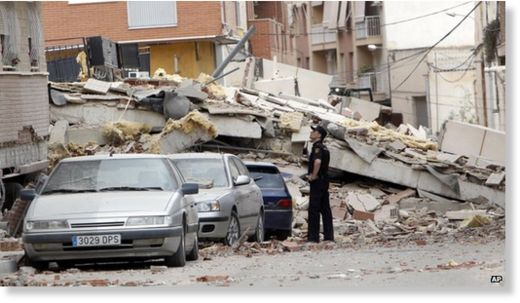
The relatively modest Magnitude 5.1 quake resulted in extensive damage and nine deaths
Scientists studying the fault beneath the Spanish city of Lorca say that groundwater removal may be implicated in a deadly 2011 earthquake there.
Detailed surface maps from satellite studies allowed them to infer which parts of the ground moved where.
They report in Nature Geoscience that those shifts correlate with locations where water has been drained for years.
The study highlights how human activity such as drainage or borehole drilling can have far-reaching seismic effects.
Pablo Gonzalez of the University of Western Ontario and colleagues used satellite radar data to trace the ground movements of the Lorca event back to their source, finding that the earthquake resulted from slippage on a comparatively shallow fault that borders a large water basin south of the city.
That the slippage happened at a depth of just 3km explains why the fairly mild Magnitude 5.1 quake caused so much damage in the area.
The team went on to study potential reasons for the slippage, finding that the water table in the adjacent Alto Guadalentin basin had dropped by some 250m over the last 50 years as water was drained for irrigation in the region.
Their calculations show that this created stresses on the fault that initially triggered the earthquake and defined its eventual magnitude.
Geoengineering dreams
However, the area lies on a seismically active region, and the data suggest only that the water drainage sped up and eventually triggered a process that would have eventually happened anyway.
Dr Gonzalez stressed the study was specific to the Lorca earthquake, telling the Reuters news agency that "we cannot set up a rule just by studying a single particular case".
"But the evidence that we have collected in this study could be necessary to expand research in other future events that occur near... dams, aquifers and melting glaciers, where you have tectonic faults close to these sources."
In an accompanying Nature Geoscience article, Jean-Philippe Avouac of the California Institute of Technology said: "It does not take much to trigger an earthquake - even strong rainfall can do the job".
"Numerous examples of seismicity triggered by the impoundment of reservoir lakes, hydrocarbon extraction, quarrying and deep well injections have been documented over the years."
Previous research has suggested that the fluid injection associated with the controversial practice of gas extraction by hydraulic fracturing or "fracking" was linked so specific earthquake events.
If science can pin down exactly how stresses from anthropogenic sources distribute and contribute to seismic events, Prof Avouac suggested, "we might dream of one day being able to tame natural faults with geoengineering".
"For now, we should remain cautious of human-induced stress perturbations, in particular those related to carbon dioxide sequestration projects that might affect very large volumes of [the Earth's] crust."

Reader Comments
to our Newsletter